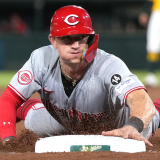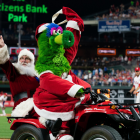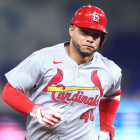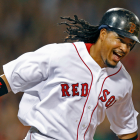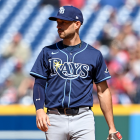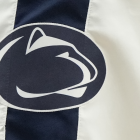Four MLB spring training stats that matter, including DJ LeMahieu's ability to hit the ball hard again
Most spring stats don't mean much, but these stood out in the last month
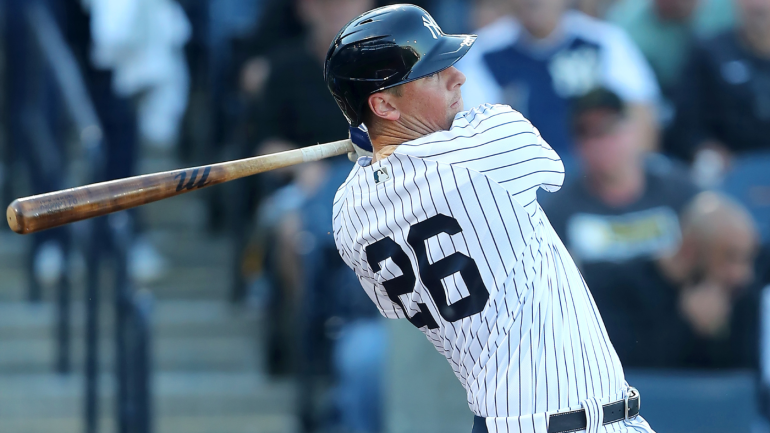
Generally speaking, spring training numbers don't mean anything. The competition varies so much -- a hitter could face a Cy Young winner in his first at-bat and a kid ticketed for Single-A in his second -- and the sample sizes are so small that it's hard to believe anything. Spring training is full of lies.
Except sometimes spring training does tell us the truth, or at least offers kernels of truth. Read between the lines and you can pick up on trends that actually mean something. A pitcher with a new pitch or a hitter with a new bat path are the kinds of things we can see in camp that can change a player's outlook. With that in mind, here are four spring training trends worth knowing ahead of MLB Opening Day 2023.
1. LeMahieu's resurgent hard-hit ability
The Yankees won 99 games a year ago and it was not a smooth ride. They were the best team in baseball the first three months of the season, then they slogged their way through two months and change of .500 ball. Aaron Judge slashed an incredible .349/.502/.785 in the second half. The rest of the Yankees hit .232/.291/.360 in over 2,300 plate appearances. Yeesh.
Infield rover DJ LeMahieu took a .285/.389/.424 batting line with more walks (55) than strikeouts (51) into August. He then suffered a right toe injury that limited how much he could rotate his foot during his swing, and he hit .195/.265/.244 during the season's final two months (while also spending time on the injured list). LeMahieu's ability to hit the ball hard completely vanished.

LeMahieu opted to rehab the toe injury in the offseason rather than have surgery because, as he described it, it would have been a "tricky" procedure with a rehab that would have sidelined him much of 2023. Reports throughout the offseason indicated LeMahieu felt good and the rehab went well, but until you see him back out on the field, you never really know, you know?
"I'm so excited where I'm at right now. How the season ended for me last year and our team, and just where I'm at physically and mentally, and to be back I feel like I'm in a really good place and really excited to be around the guys again," LeMahieu told the New York Post soon after reporting to spring training. "... It got to a point -- and I'm used to playing through stuff my whole career -- but it was so limiting that I couldn't be myself. That was extremely frustrating."
Entering play Sunday, LeMahieu was 12 for 34 (.375) with a double and a home run this spring. More importantly, he has five batted balls with a 100 mph exit velocity. That's out of 22 balls in play in Statcast parks, so 23% with 100 mph exit velocity. LeMahieu produced five 100 mph exit velocities among his final 44 balls in play last season (11%), and only two in his final 22 balls in play.
LeMahieu had a 100 mph exit velocity on 24% of his balls in play from April through July last year, before his toe began acting up, and his small sample spring training numbers are in that range. We're looking for signs the toe is healthy and LeMahieu is able to drive the ball like he did before the injury, and the batted ball data suggests LeMahieu is indeed healthy now.
Power is not LeMahieu's game. He's hit more than 15 home runs just once in his career (26 in 2019, the year of the home run), and is more of a singles and doubles guy. You still need to be able to drive the ball some though, and he was unable to do it down the stretch last season. LeMahieu is hitting the ball hard again this spring, which is a encouraging sign for him and the Yankees.
2. Taylor's strikeout issues
Since joining the Dodgers in a seemingly minor trade with the Mariners in June 2016, Chris Taylor has been one of the best and most valuable role players in the game. He's the ideal super utility guy. A "10th man" who can play every day at a different position. From 2017-21, Taylor posted a .265/.343/.461 line while playing every position other than pitcher, catcher, and first base.
Los Angeles re-signed Taylor to a four-year contract worth $60 million last offseason and he had his first real down year with the Dodgers in 2022, slashing .221/.304/.373 with a ghastly 35.2% strikeout rate. Only Joey Gallo (39.8%) had a higher strikeout rate among the 205 players with at least 400 plate appearances. Taylor's 70.7% in-zone contract was far below the 84.8% MLB average.
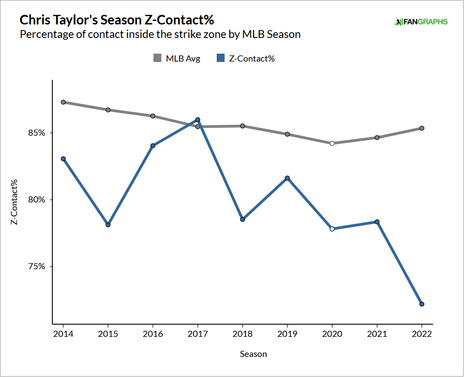
To be clear, Taylor was always a high-strikeout hitter. He led the National League with 178 strikeouts in 2018, and he posted a 27.6% strikeout rate from 2018-21. The MLB average was 22.4% in 2022. That said, 27.6% is not 35.2%. After last year's extreme strikeout problems, Taylor went to work on his swing in the offseason, focusing specifically on efficiency.
"Last season, I felt like I created some bad habits. So I'm kind of just trying to create a more efficient swing," Taylor told the Los Angeles Times earlier this spring. "... Once you step in the box, it's really difficult when you're trying to think about your mechanics. And last year was just a constant battle of trying to find it and also perform."
That more efficient swing has not solved Taylor's strikeout problems. Entering play Sunday, Taylor was 6 for 48 (.125) with 23 strikeouts this spring. In 57 plate appearances, that's a 40.4% strikeout rate. Taylor has struck out multiple times in nine of his 17 Cactus League games, which is rather incredible when you consider veterans rarely play a full nine innings in spring training.
In 2020, Jeff Zimmerman of The Hardball Times updated research on aging curves, and strikeout rates tend to climb rapidly once a hitter gets into his mid-30s. Taylor turns 33 in August and he wasn't blessed with great contact skills to begin with. It's unlikely this spring's 40.4% strikeout rate this spring is his true talent level, but it is discouraging if not worrisome after last year.
"He was really searching, was out of whack. I think he's found a little something. It's still a work in progress," Dodgers manager Dave Roberts told True Blue LA on Sunday. "But I think the last couple of days for me, he's had better intent. I think he's seen the ball much better. The swing is shorter."
3. Sampson's home run problem
Very quietly, the Cubs went 40-31 in their final 71 games last season, and journeyman right-hander Adrian Sampson was a key part of their strong finish. The 31-year-old entered the rotation on June 25 and pitched to a 3.28 ERA in 19 starts and 98 2/3 innings the rest of the way. Opponents had a .259/.311/.393 batting line, which is higher than Sampson would like, but hey, a 3.28 ERA.
"Sampson's definitely put himself in a position to be able to help us next year," Cubs manager David Ross told Marquee Sports last September. "I think he knows that. I think he pitches like that, talking about confidence in himself and ability to continue to go out and put up zeroes. A lot of guys come to mind about being really good in this second half but his performances night in and night out have stood out to me."
Sampson did make some tweaks to his pitch mix last year, specifically using fewer sinkers and more four-seam fastballs, but by and large he was the same guy he's been most of his career. That guy entered 2022 with a 5.16 ERA in 188 1/3 big-league innings. The difference between Sampson in 2022 and Sampson prior to 2022 was home runs. Look at this:
| HR/9 | HR per fly ball | |
|---|---|---|
2018-21 | 2.15 | 18.7% |
2022 | 0.86 | 7.7% |
MLB average | 1.09 | 11.4% |
Sampson's home run rate last season was wildly out of line with the rest of his career. Even with the Lotte Giants of the Korea Baseball Organization in 2020, Sampson had a 0.97 HR/9 and 17.9 HR/FB%. He's been very home run prone throughout his career. It's possible last year represented real improvement, but there was also reason to be skeptical.
Those home run issues returned with a vengeance this spring. Sampson has allowed 11 home runs -- 11! -- in only 17 2/3 Cactus League innings this year. He allowed 10 homers in 104 1/3 innings all last season and no other pitcher entered Sunday's action with more than six home runs allowed this spring. Sampson's home run problems are extreme.
The Cubs entered camp with four rotation locks -- Drew Smyly, Justin Steele, Marcus Stroman, Jameson Taillon -- and several candidates for the No. 5 spot while Kyle Hendricks works his way back from a shoulder injury. On Friday, Ross announced Hayden Wesneski won the job. Sampson was sent to Triple-A. The spring homer problems cost him a job despite pitching so well last year.
"It's a tough message to give and it's a tough one to hear. None of them want to hear that. Everybody wants to be in the big leagues and make the team on Opening Day, no matter who comes in there," Ross told Marquee Sports about sending Sampson down. "... I think the messaging for him was simple: he's earned a lot of trust around here with his performance in the big leagues."
No team makes it through the 162-game season with only five (or six, or seven) starting pitchers. At some point the Cubs will need another starter and there will be an opportunity for Sampson. He'll have to pitch well in Triple-A to get another shot, and that entails keeping the home runs in check. Maybe not at last year's level, but certainly better than he's done this spring.
4. The league-wide stolen base rate
Players are already calling this the "year of the stolen base" and the spring training stolen base rate certainly supports the idea. MLB's new rules, specifically the limit on pitcher disengagements (two pickoffs or step offs per plate appearances) and larger bases encourage steals, and players are running like crazy this spring:
| Spring SB attempts per game | Spring SB success rate | Reg. season SB attempts per game | Reg. season SB success rate | |
|---|---|---|---|---|
2018 | 1.02 | 70% | 0.71 | 72% |
2019 | 0.97 | 70% | 0.64 | 73% |
2021 | 0.82 | 72% | 0.60 | 76% |
2022 | 0.77 | 73% | 0.67 | 75% |
2023 | 1.13 | 79% | ? | ? |
More stolen base attempts and a higher success rate, which is what MLB's new rules are designed to do. MLB wants more running on the bases, more players showcasing their athleticism, and more stuff happening on the field in general. Stolen bases are exciting and MLB wants more of them, and so far, so good this spring.
With the exception of 2022, the spring training stolen base attempt rate has been 25% to 30% higher than the regular season the last few years. If that holds true this year, we're looking at 0.88 stolen base attempts per game this season, which would be the highest since 2012. Stolen bases are way up this spring. Expect them to be way up during the regular season as well.












